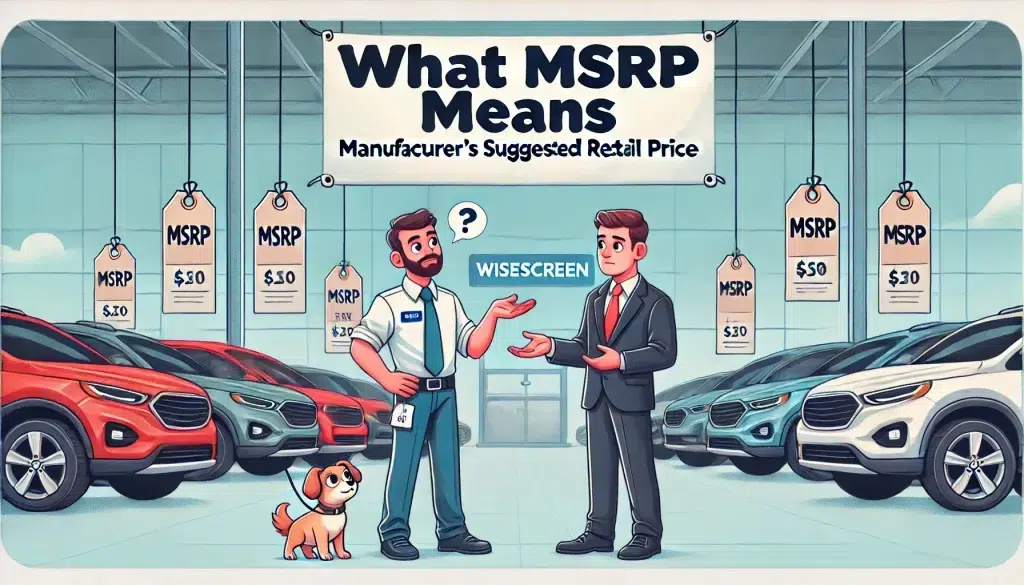
Table of Contents
- Understanding MSRP: The Basics
- The History and Evolution of MSRP
- Timeline of MSRP Development
- How MSRP is Determined
- The MSRP Calculation Process
- MSRP vs. Actual Selling Price
- Difference between MAP and MSRP
- The Role of MSRP in Different Industries
- Pros and Cons of MSRP
- MSRP and Consumer Behavior
- How Consumers Use MSRP
- MSRP in the Digital Age
- Legal Considerations Surrounding MSRP
- My Experience with MSRP
- How Pricefy Can Help You Monitor Resellers’ MSRP
- Conclusion: The Ongoing Relevance of MSRP
MSRP stands for Manufacturer’s Suggested Retail Price. It is the price that a product’s manufacturer recommends retailers use when selling the item to consumers. MSRP serves as a benchmark for pricing in the retail industry, helping to establish a consistent value for products across different sellers and locations.
A video you could find interesting
Understanding MSRP
Definition and Purpose
MSRP, also known as the list price or sticker price, is a crucial component in the retail pricing strategy. Its primary purposes include:
- Providing a starting point for negotiations between retailers and consumers
- Helping manufacturers maintain brand value and perceived quality
- Offering consumers a reference point to assess deals and discounts
- Assisting retailers in determining their profit margins
Key Points About MSRP
- MSRP is set by the manufacturer, not the retailer
- It’s not legally binding; retailers can sell above or below this price
- It helps create pricing consistency across different sellers
- It’s commonly used for automobiles, electronics, and luxury goods
- Can vary by region or country due to different market conditions
The History and Evolution of MSRP
The concept of MSRP has been around for decades, with its roots traced back to the early 20th century. Initially, it was primarily used in the automotive industry to prevent price gouging and ensure fair competition among dealerships.
Timeline of MSRP Development
- 1930s: The concept gains traction in the automobile industry
- 1950s: It becomes more widely adopted across various retail sectors
- 1975: The Magnuson-Moss Warranty Act indirectly affects MSRP by prohibiting tied selling in most cases
- 1990s-2000s: The rise of e-commerce challenges traditional MSRP models
- Present day: It continues to evolve with dynamic pricing strategies and increased market transparency
How MSRP is Determined

Manufacturers consider several factors when setting the MSRP for a product:
- Production costs
- Target profit margins
- Competitor pricing
- Market demand
- Brand positioning
- Economic conditions
- Distribution costs
The MSRP Calculation Process
While the exact formula can vary, here’s a general step-by-step approach manufacturers might use to calculate MSRP:
- Clculate the total cost of production
- Add desired profit margin
- Consider competitor pricing and market positioning
- Factor in distribution and marketing costs
- Adjust for regional variations and economic conditions
- Round to a psychologically appealing price point
MSRP vs. Actual Selling Price
It’s important to note that the MSRP is often different from the actual selling price. According to a 2022 study by J.D. Power, the average new vehicle in the United States sold for 3.7% above MSRP. This discrepancy can be attributed to various factors:
- Supply and demand fluctuations
- Retailer promotions and discounts
- Negotiation between buyers and sellers
- Market competition
- Product lifecycle stage
Difference between MAP and MSRP
While often confused, Minimum Advertised Price (MAP) and Manufacturer’s Suggested Retail Price (MSRP) are distinct concepts in retail pricing:
MSRP (Manufacturer’s Suggested Retail Price)
- Set by the manufacturer as a recommended selling price
- Not legally binding; retailers can sell above or below this price
- Serves as a reference point for consumers and retailers
- Typically higher than the actual selling price
- Used across various industries
MAP (Minimum Advertised Price)
- The lowest price at which resellers agree to advertise a product
- Part of a legal agreement between manufacturer and retailer
- Doesn’t restrict the actual selling price, only the advertised price
- Often lower than MSRP
- Commonly used in industries with complex distribution channels
Key differences:
- Purpose: MSRP is a suggestion for the final selling price, while MAP is a lower limit for advertised prices.
- Enforcement: MAP is typically part of a contractual agreement, while MSRP is a non-binding suggestion.
- Flexibility: Retailers have more flexibility with MSRP, as they can openly advertise prices below it. With MAP, they can sell below the specified price but cannot advertise it.
- Consumer perception: MSRP is more visible to consumers and often used as a reference for “savings,” while MAP operates more behind the scenes.
Understanding the distinction between MAP and MSRP is crucial for both retailers and manufacturers in developing effective pricing strategies and maintaining brand value. Consumers should be aware that these policies can affect the advertised prices they see, particularly in online marketplaces.
The Role of MSRP in Different Industries
While MSRP is commonly associated with the automotive industry, it plays a significant role in various sectors:
Automotive Industry
In the car market, MSRP is prominently displayed on the window sticker of new vehicles. According to Kelley Blue Book, the average new car MSRP in the U.S. was $48,763 in July 2023.
Electronics
Consumer electronics often have an MSRP, but actual prices can vary widely due to rapid technological advancements and compettive markets.
Luxury Goods
High-end brands use MSRP to maintain perceived value and exclusivity. Luxury goods often sell at or near MSRP to preserve brand image.
Furniture and Appliances
These industries frequently use MSRP, but actual selling prices can be significantly lower due to regular sales and promotions.
Pros and Cons of MSRP
Advantages
- Provides a reference point for consumers
- Helps maintain brand value and product positioning
- Facilitates price consistency across different retailers
- Assists in inventory valuation for accounting purposes
Disadvantages
- May not reflect actual market value or demand
- Can be misleading if significant discounts are common
- Potentially limits retailer flexibility in pricing
- May not account for regional economic differences
MSRP and Consumer Behavior
MSRP significantly influences consumer purchasing decisions. A study published in the Journal of Consumer Research found that consumers perceive greater savings when discounts are framed relative to the MSRP, even if the final price is the same.
How Consumers Use MSRP
- As a starting point for negotiations
- To compare prices across different retailers
- To assess the value of discounts and promotions
- As a benchmark for determining a “fair” price
MSRP in the Digital Age
The internet and e-commerce have dramatically changed how consumers interact with MSRP:
- Price comparison tools make it easy to find the lowest prices
- Online reviews and forums provide insights into fair pricing
- Dynamic pricing strategies challenge traditional MSRP models
- Direct-to-consumer brands often eschew MSRP in favor of transparent pricing
Legal Considerations
While setting an MSRP is legal, there are regulations to prevent its misuse:
- Price fixing between manufacturers and retailers is illegal in many countries
- Retailers must be free to set their own prices
- Misleading advertising related to MSRP can lead to legal consequences
- Some regions require MSRP to be clearly displayed on products
My Experience, as consumer, with MSRP
As a consumer, I’ve found MSRP to be a useful starting point when shopping for big-ticket items like electronics and appliances. However, I’ve learned to treat it as just one factor in my decision-making process. I often use MSRP as a benchmark to evaluate deals, but I also consider other factors like product reviews, features, and long-term value.
In my experience, the actual selling price can vary significantly from the MSRP, especially during sales events or when purchasing last year’s models. I’ve found that being aware of MSRP helps me negotiate better deals, particularly when buying cars or furniture.
How Pricefy Can Help You Monitor Resellers’ MSRP
Pricefy offers powerful tools to effectively track and analyze how resellers are using MSRP in their pricing strategies.
Here’s how Pricefy can assist you in monitoring resellers’ MSRP:
- Comprehensive MSRP Tracking: Pricefy allows you to monitor MSRP adherence across multiple resellers and marketplaces, giving you a bird’s-eye view of how your products are being priced in the market.
- Deviation Alerts: Set up automated alerts that notify you when resellers price your products significantly above or below the MSRP, helping you quickly identify and address potential pricing issues.
- Competitive Analysis: Compare how different resellers are pricing your products relative to MSRP, allowing you to identify which partners are maintaining your suggested pricing and which may be undercutting the market.
- Historical Trend Analysis: Access historical data on how resellers have priced your products relative to MSRP over time, enabling you to spot patterns and anticipate future pricing behaviors.
- MAP Compliance: While distinct from MSRP, Pricefy can help you monitor reseller compliance with your MAP policies, which often work in conjunction with MSRP strategies.
- Channel-specific Insights: Gain detailed insights into how MSRP is being utilized across different sales channels, from major e-commerce platforms to individual reseller websites.
- Customized Reporting: Generate comprehensive reports on reseller MSRP adherence, providing valuable data for strategic discussions with your sales team and reseller partners.
By leveraging Pricefy‘s capabilities, you can gain a deeper understanding of how resellers are using your MSRP in their pricing strategies. This insight can help you maintain brand value, ensure pricing consistency, and develop more effective partnerships with your resellers.
Useful Links
Certainly! Here are some useful links from reputable and institutional domains that provide additional information about MSRP and related topics:
- Federal Trade Commission (FTC) – Manufacturer-imposed Requirements
- U.S. Department of Justice – Price Fixing, Bid Rigging, and Market Allocation Schemes
- Cornell Law School – Legal Information Institute – Resale Price Maintenance
- Harvard Business Review – The Good-Better-Best Approach to Pricing
- Massachusetts Institute of Technology (MIT) Sloan – Pricing
- Stanford Graduate School of Business – Pricing Strategy
- American Marketing Association – Pricing Strategies
Conclusion: The Ongoing Relevance of MSRP
In summary, MSRP remains a significant factor in retail pricing strategies, despite changes brought about by e-commerce and increased market transparency. Key points to remember:
- It provides a baseline for product pricing
- It serves multiple purposes for manufacturers, retailers, and consumers
- Actual selling prices often differ from MSRP due to various market factors
- It influences consumer perceptions and purchasing decisions
- The digital age has changed how MSRP is used and perceived
- Legal considerations exist to prevent misuse of MSRP
Understanding MSRP and its implications is crucial for both businesses and consumers in navigating the complex landscape of retail pricing. As markets continue to evolve, the role of MSRP is likely to adapt, maintaining its relevance in the retail ecosystem.




